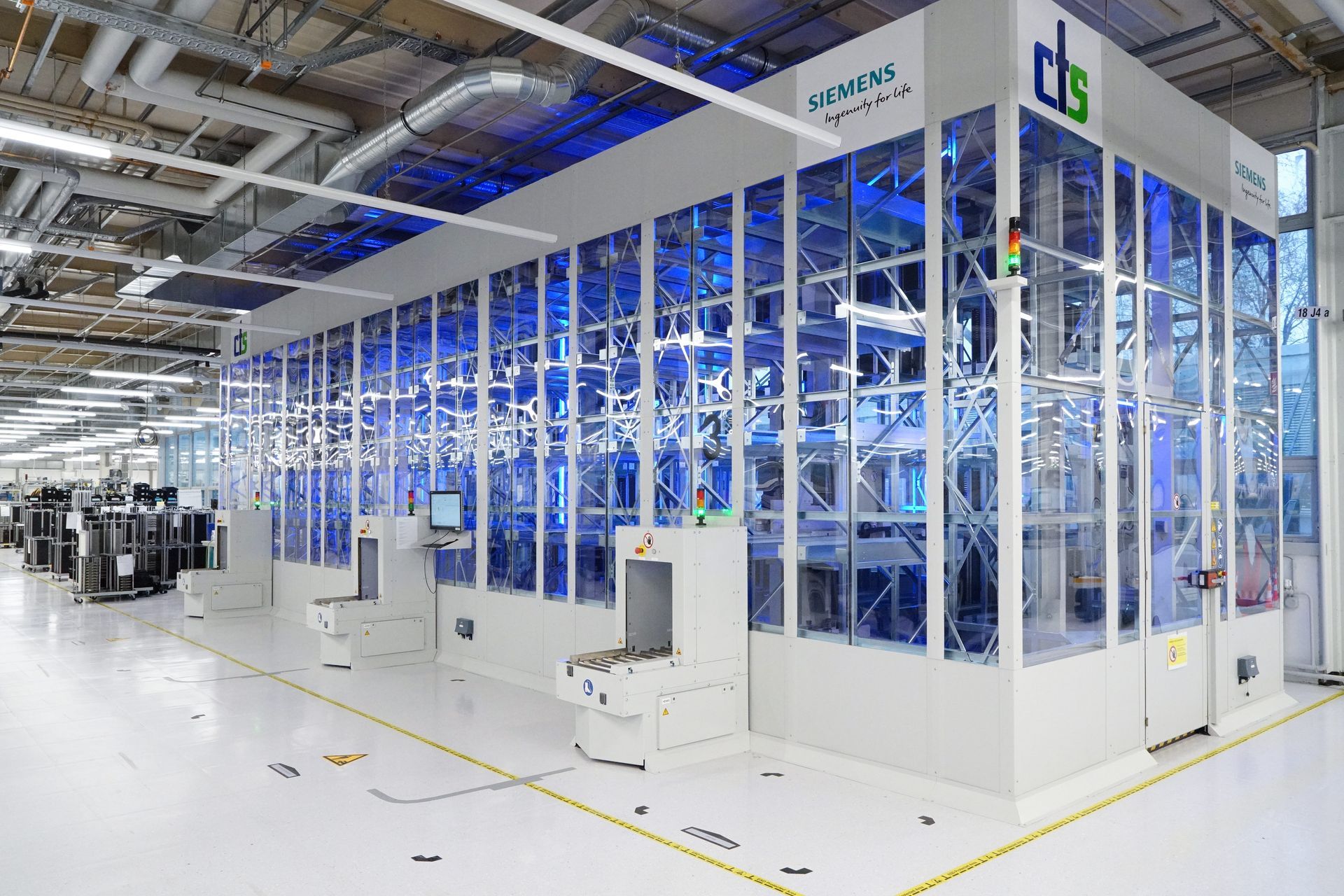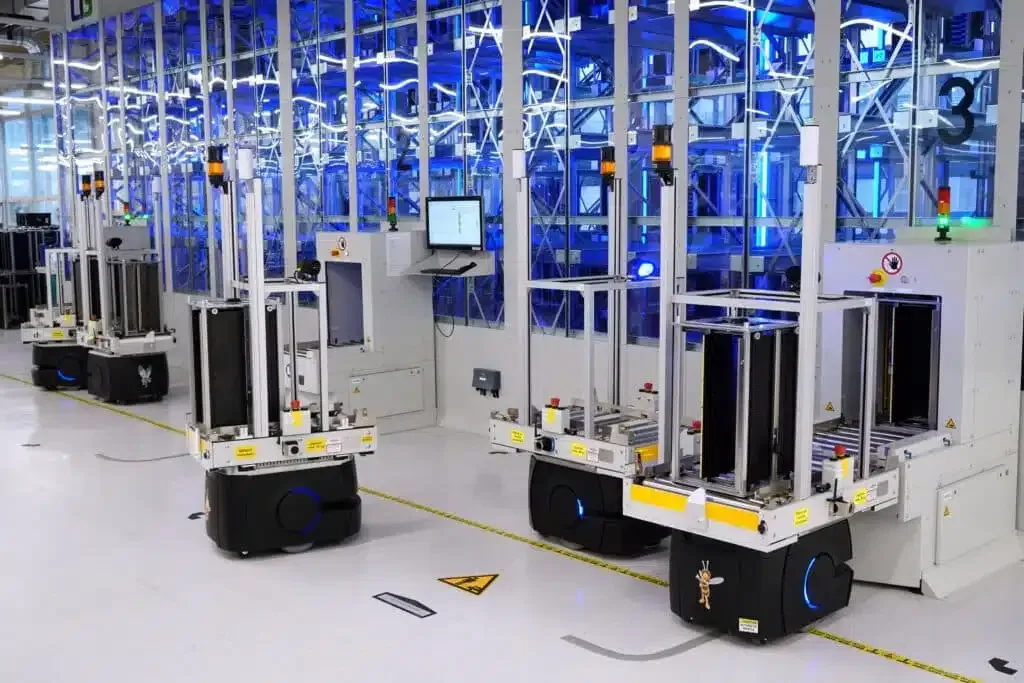Automated storage - cts Smart Warehouse in use at Siemens

With the fully automated Smart InProduction Warehouse and autonomous transport robot solutions, CTS has automated the supply of flat modules for Siemens' electronics production in Karlsruhe. Following a modernization carried out by the automation specialist CTS, the storage system of the Upper Bavarian automation specialist offers space for more than 680 magazines, which are transported autonomously to the respective production and assembly lines by seven transport robots.
“We had been looking for more efficient solutions for the decoupling and short-term buffering of flat module magazines in conjunction with our autonomous transport robots for some time for our electronics production - however, an intelligent and automated storage system at the level we were looking for was not available on the market,” explains Sascha Geiger from Disruptive and Special Technology Support at Siemens in Karlsruhe.
Around 1,000 employees at the electronics plant are involved in the production of more than 2,000 product variants, primarily from the digital industry sector. Previously, magazines with printed circuit boards were manually placed on trolleys by operators after SMT assembly and transported to assigned storage areas in the downstream processes, where they were fed by hand. In order to meet Siemens' technological and quality standards and achieve a higher degree of automation, a much more modern, productive and efficient solution was urgently required.

“CTS had already successfully implemented transport robot solutions at Siemens Karlsruhe. CTS was very receptive to our request for a highly automated in-production warehouse - necessary to achieve a closed transport cycle without manual intervention - so that we were able to start the joint concept and design phase in 2019. The system was delivered to us and assembled in the fall of 2020 and, after extensive functional and integration tests, we were able to integrate the Smart In-Production Warehouse into our processes in March 2021 and now benefit from a fully automated and highly efficient transport process with complete traceability,” continues Sascha Geiger.
Interaction of software and hardware
Storage solution with open connectivity: The Smart In-Production Warehouse from CTS is an intelligent, modular and highly effective automated storage solution for the store floor. It significantly reduces the amount of valuable production space occupied by PCB magazines, small load carriers or other containers that would otherwise be placed or stacked manually. With mechanical and software interfaces for AMR/AIV (Autonomous Mobile Robots/Autonomous Intelligent Vehicles), it enables complete automation of the material flow in production on request. The size of the storage system can be varied between around 8.5 and 20 m in length and 4 m in width, offering space for 400 to 1,300 standard PCB magazines. At its core, an innovative, space-saving gripper system ensures effective storage and retrieval in relation to the storage area. The storage/retrieval ports can be positioned flexibly and as required at different positions on one side - they only require one shelf space each. The software structure is just as modular. An open connectivity REST interface enables simple and comprehensive connection to MES and ERP systems or middleware for controlling AIV/AMR fleets.
Solutions perfectly tailored to the customer
The CTS specialists developed a tailor-made concept for Siemens. The processing of two PCB magazines of different sizes, which are used in Siemens' electronics production, had to be guaranteed. An automatic width adjustment of their transport attachments was planned and designed for the AMRs/AIVs to be used. The storage locations in the warehouse were adapted accordingly in order to achieve optimum capacity distribution. One challenge was the ground conditions on site. The installation team also designed a special floor treatment to ensure stable installation of the storage system and obstacle-free paths for the transport robots.
The first phase of the project involved transporting the PCB magazines between the lines: a fleet of six CTS AMRs based on the Omron LD90 with a loading capacity of up to 90 kg and a transport system from another manufacturer relieved the employees at the lines of walking distances. Where necessary, the AMRs were equipped with automatic width adjustment so that the two magazine sizes used could be handled efficiently. For this purpose, Siemens manufactured gravity-based roller conveyors as mini buffers, which are filled or emptied by the AMRs. CTS's own AIV Framework middleware handles the allocation of transport orders to the AMR/AIV. The smart solution can be used to manage non-uniform transport robot fleets of up to 100 vehicles. The flexible, Siemens-owned intralogistics platform knows the status of each production line and calculates the material required in the future to fulfill production planning. The two systems communicate with each other via an open REST interface and the Siemens intralogistics platform transmits the necessary requirements to the AIV framework in order to synchronize the creation of transport orders with the Siemens solutions. However, this step was not yet able to completely prevent the use of parts of the production area as a warehouse, as the production environment was too complex and heterogeneous.
More usable production space thanks to In-Production Warehouse
The integration of the In-Production Warehouse, located close to production, as a central and fully automated material supply station freed up the tight production area from the magazines stored there temporarily: around 13 m long, 4 m wide and 4 m high, it now offers efficiently usable storage space for more than 680 PCB magazines in the two sizes used by Siemens Karlsruhe. The storage solution is equipped with three storage/retrieval ports that enable both manual access and handling via AMR/AIV solutions - regardless of whether from CTS or third-party providers. In this way, Siemens achieves complete automation of the PCB magazine material flow and at the same time keeps the option open for operators to intervene themselves if required.
Another advantage of the new solution: Siemens' own Scalance RFID technology for WiP (Work in Process) tracking of the PCBs is integrated into the storage/retrieval ports. This ensures complete traceability throughout the entire production chain. An intelligent storage and optimization algorithm makes it possible for the warehouse to optimally distribute stored PCB magazines during idle phases in order to enable the fastest possible retrieval.
The Smart In-Production Warehouse is thus fully integrated into the fully automated process flow in order to load and unload the AMR fleet, which in turn supplies all automated production and assembly lines connected to the system or collects material from there. The CTS middleware AIV Framework is connected to the modular, intelligent intralogistics platform from Siemens, which contains the entire transport logic and transmits transport requests for the AMRs/AIVs as well as storage and retrieval orders for the warehouse to the CTS middleware as output and receives information on content, status and performance from it. In parallel to the AMRs/AIVs, storage and retrieval can be carried out by employees for manual or partially automated lines or lines that are not connected via data technology.
Ready for the new
The concept of automatic transport robots and an in-production warehouse is a success for Siemens Karlsruhe. Another fully automated warehouse system is already being planned. This project has also attracted a great deal of attention within the Siemens Group in a short space of time - there have already been inquiries from other locations for similar solutions.
“With the concept of automatic transport robots and the fully automated CTS In-Production Warehouse, we can concentrate on core processes and thus produce significantly faster, better and smarter,” summarizes Markus Ziehl, Head of the Technology Matrix department. “The new solution relieves our employees and reduces non-value-adding activities to a minimum. Time-consuming searches for magazines are no longer necessary, as the location of each individual PCB is always known. In addition, we were able to save several square meters of valuable production space. We have received a highly innovative and disruptive solution that fully meets Siemens' high standards in terms of quality and safety. Thanks to the leap in productivity and efficiency we have achieved, we expect an attractive return on our investment.”
His colleague Sascha Geiger adds:
“In the meantime, we are looking forward to further projects with CTS that will enable us to make our production even more productive and competitive.”


